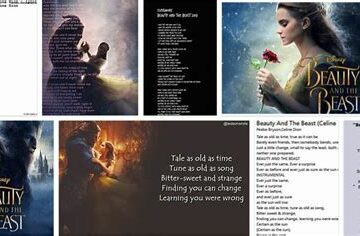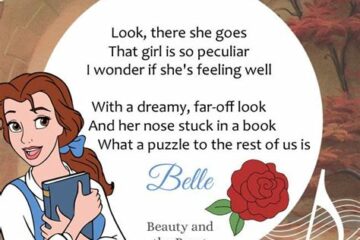
The Role Of Villains In Beauty And The Beast Lyrics
In the enchanting world of Disney’s Beauty and the Beast, villains play a crucial role that transcends mere antagonism, weaving complex narratives that resonate with audiences of all ages. This article delves into the multifaceted nature of villains within the beloved lyrics of this classic tale, unlocking their contribution to character development, emotional engagement, and overarching themes. By examining the intricate motifs present in the lyrics, we can appreciate how these nefarious figures not only challenge the protagonists but also illuminate their virtues and growth. The exploration will provide a deeper understanding of how the dynamics of villainy enhance storytelling, enriching the experience of Beauty and the Beast beyond its surface charm. Join us as we unravel the compelling impact of villains and their unwavering presence in Disney narratives.
Understanding The Role Of Villains In Disney Narratives
In Disney narratives, villains play a crucial role in shaping the overall story arc and character development. They are not merely antagonists; instead, they are essential catalysts that push the protagonists into action and force them to confront the inherent challenges of their world. This dynamic creates a compelling contrast that accentuates the virtues of the heroes while highlighting the dark themes represented by the villains.
One of the significant aspects of The Role of villains in Disney stories is their ability to embody societal fears and moral lessons. They often represent the darker impulses of humanity, serving as a foil to the hero’s nobility and moral righteousness. For instance, in Beauty and the Beast, the Beast’s struggle with inner demons can be seen as a reflection of the villain Gaston’s arrogance and entitlement, which ultimately leads to profound character growth.
Moreover, the complexities of villains enrich the narrative, allowing for deeper emotional engagement. Audiences may find themselves empathizing with the villain’s backstory or motivations, which adds layers to the storytelling. This narrative technique fosters a more profound understanding of the moral complexities of both good and evil.
Disney villains often initiate critical turning points in the narrative, creating moments that challenge the protagonist’s beliefs. These encounters are frequently designed to evoke a range of emotions, from fear and anger to pity and understanding. Thus, understanding The Role of villains is essential for appreciating the intricate storytelling that has become a hallmark of Disney’s animated masterpieces.
Character Development: Villains And Their Impact On Protagonists
In the enchanting world of storytelling, especially within Disney narratives, The Role of villains cannot be overstated. They serve as catalysts for the development of the protagonists, pushing them to confront their fears and ultimately grow. In the context of Beauty and the Beast, the villains play a crucial part in shaping the main characters’ journeys.
The Beast, initially portrayed as a fearsome figure, undergoes significant transformation as the plot unfolds. His interactions with characters like Gaston and the Enchanted Rose create a framework that highlights his vulnerability. The presence of Gaston, a quintessential antagonist, forces the Beast to confront his past and his personal demons. This conflict is essential, illustrating how villains can spark introspection and self-discovery in protagonists.
Moreover, Belle’s character development is closely tied to the presence of these villains. Her strength and compassion are put to the test through her encounters with Gaston and the societal pressures he represents. As a villain, Gaston embodies self-centeredness and dominance, serving as a foil to Belle’s bravery and kindness. The contrast between them not only propels the narrative forward but also emphasizes Belle’s growth as she stands up against toxic masculinity and defies societal expectations.
The portrayal of villains in Beauty and the Beast offers a rich dimension to character development. The Role of these antagonists is not merely to create conflict; rather, they are integral to shaping the protagonists’ paths, enabling them to evolve and emerge stronger through adversity.
The Role Of Villains: Examining Motifs In Beauty And The Beast Lyrics
The lyrics of Beauty and the Beast serve as a rich tapestry, weaving various motifs that highlight the complexities of its villains. The central villain, Gaston, is not merely an antagonist but a character that embodies themes of arrogance, toxic masculinity, and societal expectations. These motifs are intricately tied to his character through the lyrics, allowing the audience to grasp the underlying message about the nature of true beauty and the consequences of vanity.
One prominent motif in Gaston’s lyrics is the idea of conformity. He represents a societal archetype, boasting about his physical prowess and the importance of external appearance. This insistence on outward beauty contrasts sharply with the virtues exhibited by Belle, illustrating the struggle between superficiality and authenticity. The lyrics amplify this duel, portraying Gaston as the epitome of a misguided hero, clamoring for recognition and validation through dominance rather than genuine connection.
Moreover, the motif of fear emerges through the depiction of villagers rallying around Gaston. His powerful presence is a reflection of societal control, a reminder that individuals can be swayed by those who present a false sense of security or leadership. The lyrics capture this dynamic, revealing how fear can manipulate the masses and stifle the individual spirit, a theme that resonates with many modern narratives.
The relationship between Gaston and the Beast also underscores another significant motif: redemption versus corruption. While the Beast’s journey is one of transformation fueled by love and acceptance, Gaston’s character remains static, consumed by jealousy and a thirst for power. This juxtaposition in the lyrics serves to reinforce the idea that while one can choose the path of redemption, another can spiral further into darkness.
Analyzing the motifs present in the lyrics of Beauty and the Beast elucidates the role of villains within the narrative structure. Through Gaston’s character, the song empowers themes of identity, societal pressure, and the choices between corruption and redemption. These motifs not only serve to enhance the storytelling but also engage the listener in a profound reflection on what it means to be truly beautiful.
Emotional Engagement: How Villains Enhance The Storytelling Experience
The role of villains in storytelling, particularly in narratives like *Beauty and the Beast*, serves more than just a backdrop for the protagonist’s journey. They are pivotal in crafting emotional engagement that resonates with the audience. A well-developed adversary often evokes a complex blend of feelings—fear, empathy, and even a tinge of excitement—that propels the story forward.
In *Beauty and the Beast*, the character of Gaston exemplifies this notion. His charismatic yet toxic personality not only creates tension but also heightens the stakes for Belle and the Beast. As viewers witness the struggles the protagonists face against Gaston’s relentless pursuit and cruelty, the emotional stakes are raised, leading to a more profound connection with the characters.
Moreover, villains often serve to highlight the strengths and weaknesses of the heroes. For example, Belle’s kindness and bravery contrast sharply with Gaston’s arrogance and power-hungry nature, allowing the audience to engage more deeply with her character. This juxtaposition not only provides clarity to Belle’s motivations but also allows the audience to invest emotionally in her journey to overcome the villain’s influence.
Additionally, the lyrical elements of *Beauty and the Beast* further amplify this emotional engagement. Through the songs, we gain insights into the complexities of villainous characters, often revealing their vulnerabilities or misguided intentions. This deeper understanding can elicit sympathy or even contemplation about the root causes of their villainy, fostering an emotional response from the audience.
The role of villains in enhancing the storytelling experience cannot be overstated. By creating emotional depth and engagement, they enrich the narrative, making the heroes’ journeys all the more relatable and impactful.
Analyzing The Consequences Of Villainy In Beauty And The Beast Themes
The role of villains in any narrative is to challenge the protagonist and create conflict, and this is particularly evident in Beauty and the Beast. The consequences of villainy in this story serve to highlight essential themes and moral lessons that resonate throughout the plot.
Firstly, the character of Gaston embodies the theme of toxic masculinity. His relentless pursuit of Belle, fueled by entitlement and lust, not only illustrates his selfish nature but also contrasts sharply with the Beast’s journey towards redemption. This juxtaposition emphasizes that true strength lies in character and kindness, rather than brute force or dominance. As a result, the villain’s actions lead the audience to reevaluate the nature of heroism and the qualities that define a true hero.
Furthermore, the consequences of Gaston’s villainy extend beyond his personal narrative to affect the entire village. His influence promotes a culture of superficiality, where appearances are valued over true qualities. This societal commentary serves as a reflection on our own world, highlighting the dangers of succumbing to societal pressures and unhealthy ideals. The role of Gaston as a villain ultimately leads to significant transformations in Belle and the Beast, pushing them to seek love and acceptance beyond physical appearances.
Additionally, the emotional fallout from the villain’s actions underscores the importance of empathy and understanding. The Beast, once a fearsome figure, becomes a symbol of redemption as he confronts his past and learns to love. The consequences of Gaston’s cruelty serve as a catalyst for this transformation, making the narrative not only compelling but also deeply relatable for audiences. Through the lens of villainy, Beauty and the Beast elevates its themes of love, sacrifice, and personal growth.
The role of villains in Beauty and the Beast is crucial in shaping the narrative and themes. By analyzing the consequences of villainy, we gain a deeper understanding of the message behind the lyrics and the character journeys. This exploration not only enriches our appreciation of the story but also encourages us to reflect on the complexities of human nature and moral choices.
Top 10 Disney Characters You Didn’t Know About
December 30, 2024A Deep Dive Into Disney Princesses And Their Stories
December 29, 2024The Meaning Behind Beauty And Beast Lyrics
December 29, 2024Why Beauty And The Beast Is A Timeless Disney Classic
December 29, 2024The Role Of Disney Princesses In Modern Culture
December 29, 2024Exploring The Themes In Beauty And The Beast Lyrics
December 28, 2024
Leave a reply Cancel reply
Recommended
-
Rediscovering Classic Disney Characters In New Media
December 19, 2024 -
Exploring The Mythology And Origins Of Beauty And The Beast
December 6, 2024 -
Something There by Robin Thicke – Original Version
July 7, 2021









